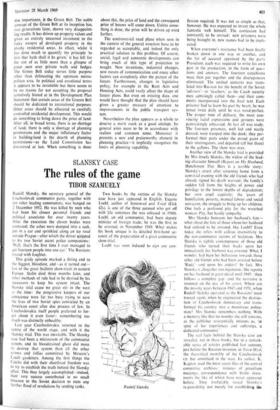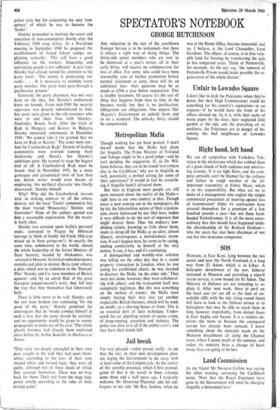The rules of the game
SLANSKY CASE TIBOR SZAMUELY
Rudolf Slansky, the secretary general of the Czechoslovak communist party, together with ten other leading communists, was hanged on 2 December 1952. He was killed by men who had been his closest personal friends and political associates for over twenty years. After the execution the eleven bodies were cremated; the ashes were dumped into a sack, put in a car and sprinkled along an icy road outside Prague—after which the driver quipped to his two Soviet secret police companions: 'Well, that's the first time I ever managed to get fourteen people into one car.' The Russians roared with laughter.
This grisly episode marked a fitting end to the biggest, bloodiest, and—as it turned out- last of the great Stalinist show-trials in eastern Europe. Stalin -died three months later, and other methods of rule had to be devised by his successors to keep his system intact. The Slansky trial cause no great stir in the west at the time: the progressive keepers of our conscience were far too busy trying to save the lives of two Soviet spies convicted by an American court after due process of law. In Czechoslovakia itself people preferred to for- get about it even faster: remembering too much was distinctly unhealthy.
Last year Czechoslovakia returned to the centre of the world stage, and with it the Slansky trial. This was inevitable. The Slansky case had been a microcosm of the communist system, and its bloodstained ghost did more to destroy that system than all the other crimes and follies committed by Moscow's Czech gauleiters. Among the first things the Czechs did with their shortlived freedom was to try to establish the truth behind the Slansky affair. This they largely accomplished—indeed, their very success contributed in no small measure to the Soviet decision to stem any further flood of revelations by sending tanks.
Two books by the victims of the Slansky case have just appeared in English. Eugene Loebl, author of Sentenced and Tried (Elek 42s), is one of the three accused who got off with life sentences (he was released in 1960). Loebl, an old communist, had been deputy minister of foreign trade; he was the first to be arrested, in November 1949. What makes his book unique is its detailed first-hand ac- count of the preparation of a great communist show-trial.
Loebl was soon induced to sign any con-
Rudolf Slansky
fession required. It was not as simple as that, however. He was expected to invent the whole fantastic web himself. The confession had constantly to be revised: new prisoners were being brought in, new names had to be impli- cated.
When everyone's resistance had been finally broken down in one way or another, and the list of accused approved by the party Presidium, each was required to write his own part in the production, in the form of ques- tions and answers. The fourteen catechisms were then put together and the discrepancies eliminated. The unified scenario was trans- lated into Russian for the benefit of the Soviet 'advisers'—or 'teachers,' as the Czech security men admiringly called them—and their com- ments incorporated into the final text. Each prisoner had to learn his part by heart; he was tested twice daily until he was word-perfect. The proper tone of delivery, the most con- vincing facial expressions and gestures were painstakingly rehearsed. At last all was ready. The fourteen prisoners, well fed and neatly dressed, were trooped into the dock; they per- formed their parts under the proud gazes of their interrogators, and departed (all but three) to the gallows. The show was over.
Another view of the Slansky trial is provided by Mrs Josefa Slanska, the widow of the lead- ing character himself (Report on My Husband, Hutchinson 35s). Hers is a terrible story: Slansky's arrest after returning home from a convivial evening with the old friends who had already signed his death warrant; the family's sudden fall from the heights of power and privilege to the lowest depths of degradation; her own cruel captivity; the years of humiliation, poverty, manual labour and social ostracism, the struggle to bring up her children. One feels a profound pity for the wretched woman. Pity, but hardly sympathy.
Mrs Slanska bemoans her husband's fate— what about the fate of those whom her husband had ordered to be arrested, like Loebl? Even today she refers with callous insensitivity to the non-communist victims of Stalinism. Mrs Slanska is rightly contemptuous of those old friends who turned their backs upon her immediately her husband was arrested. What, I wonder, had been her behaviour towards those other old friends who had been arrested before `Ruda'—and upon his orders? In fact, Mrs Slanska is altogether too ingenuous. She reports on her husband in great detail until 1945—then follows a complete gap--and the narrative is resumed on the day of his arrest. Where are the missing years between 1945 and 1951, when Rudolf Slansky operated as the Russians' most trusted agent, when he engineered the destruc- tion of Czechoslovak democracy and trans- formed his country into a monstrous police- state? Mrs Slanska remembers nothing. With a memory like that no wonder she still remains, as the publisher reverentially informs us, 'in spite of her experiences and sufferings, a dedicated communist.'
The real facts behind the Slansky case are revealed, not in these books, but in a remark- able series of articles published last summer, just before the Russian invasion, in Nova Mysi, the theoretical monthly of the Czechoslovak CP. but unnoticed in the west. Its author, K. Kaplan. used the most secret files of the central committee archives: minutes of presidium meetings, correspondence with Stalin—docu- ments the like of which have never appeared before. They irrefutably reveal Slansky's responsibility not merely for establishing the
police state but for concocting the very 'con- spiracy' of which he was to become the 'leader.'
Slansky proceeded to institute the arrest and execution of non-communists shortly after the February 1948 coup d'etat. At a Presidium meeting in September 1948 he proposed the establishment of forced labour camps, ex- plaining cynically : 'This will have a good influence on the workers. Educating and convincing people is not sufficient.' A year later Slansky had already turned his attention to the party itself: 'The enemy is penetrating our ranks . . . It is necessary to examine every party member. Our party must pass through a purification process.'
Gottwald, the party chairman, was not very keen on the idea, but Slansky's enthusiasm knew no bounds. From mid-1949 the security apparatus was directly subordinated to him; key posts were given to the vile creatures who were to end their lives with Slansky : Geminder, Reicin, Svab. After the trials of Rajk in Hungary and Kostov in Bulgaria Slansky ominously announced, in December 1949: `We cannot take it for granted that we have no Rajk or Kostov.' The order went out: find the Czechoslovak Rajk! Dozens of leading communists were arrested (among them Smrkovsky and Husak), but Slansky's ambitions grew. He wanted to stage the biggest trial of all. A Czechoslovak Rajk must be found. And in November 1951, by a more grotesque and paradoxical twist of fate than any fiction writer would even dream of employing, this mythical character was finally discovered: Slansky himself.
Why? Why did the Czechoslovak treason trial, in striking contrast to all the others, destroy, not the local `Titoist' communists but the most trusted 'Muscovites,' Slansky and Geminder? None of the authors quoted can find a reasonable explanation. Yet the matter is fairly clear.
Slansky was arrested upon Stalin's personal order, conveyed to Prague by Mikoyan (strange to think of kindly old Uncle Mikoyan mixed up in these goings-on!). At exactly the same time, unbeknown to the world, almost the whole leadership of the Soviet Ministry of State Security, headed by Abakumov, was arrested in Moscow. Stalin had embarked upon a complicated plan to destroy Beria (and others), a plan, which was to culminate in the 'Doctors' Plot.' Slansky and Co. were members of Beria's apparat—and, by an adroit flick of the great Georgian puppet-master's wrist, they fell into the trap that they themselves had laboriously built.
There is little more to be said. Slansky and the rest were broken into confessing 'for the good of the party.' Slansky promised his interrogator that he 'would conduct himself in such a way that the party should be satisfied, and no opportunity would be given to enemy propaganda to make use of his case.' The whole ghastly business had already been explained years before by Arthur Koestler in Darkness at Noon: 'They were too deeply entangled in their own past, caught in the web they had spun them- selves, according to the laws of their own twisted ethics and twisted logic; they were all guilty, although not of those deeds of which they accused themselves. There was no sway back for them. Their exit from the stage hap- pened strictly according to the rules of their strange game.'



































 Previous page
Previous page